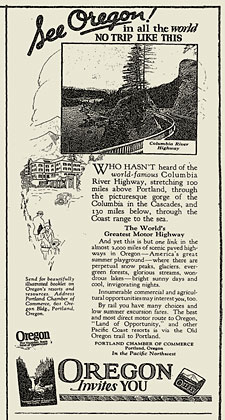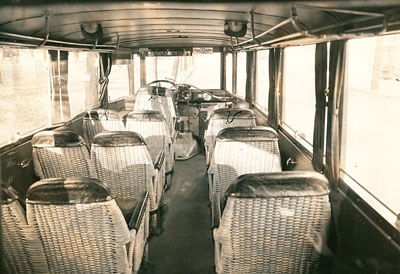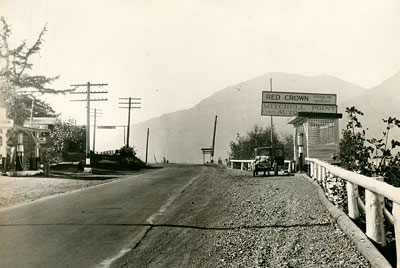A Columbia Gorge Motor Coach System bus in 1928. (Oregon State Archives, Oregon Supreme Court Case File 6664)
An Intoxicating Blend

A Portland Chamber of Commerce advertisement for the highway invites tourism on the highway in a 1924 edition of the New York Times newspaper. Enlarge image.
(Public Domain)
A section of the new highway opened from Troutdale to Hood River in 1915 and Portlanders quickly embraced it. The next year, the highway gave people the novel pleasure of driving on a paved road through a natural wonderland. The completed route opened up attractions along the way such as Vista House, Multnomah Falls and Rowena Crest. Promoters advertised the road nationally and businesses quickly sprouted up on the highway.
 The interior of the bus shown above featured wicker seats and large windows for a great view of the scenery. (Oregon State Archives, Oregon Supreme Court Case File 6664)
The interior of the bus shown above featured wicker seats and large windows for a great view of the scenery. (Oregon State Archives, Oregon Supreme Court Case File 6664)
Sam Hill captured the mood: "Tourists want three things; a good road to drive on, something worthwhile to see, and something worthwhile to eat. We will cash in, year after year, on our crop of scenic beauty, without depleting it in any way.” New hotels, such as Simon Benson’s Columbia Gorge Hotel, offered lodging and food. Taverns and roadhouses served locally distilled spirits in spite of Prohibition.
The freedom that cars brought also intoxicated vacationers, many of whom soon preferred auto touring and staying at auto camps to following train schedules and sleeping in stuffy hotels. Other tourists hopped on tour buses. Gas stations, food stands and other businesses also capitalized on the new market. These energized the economies of Gorge towns such as Cascade Locks and Hood River.
The Oregon Parks and Recreation Department now plays a key role in offerings for tourists. Land donated by Simon Benson and others led to the creation of several state parks in the Gorge. Various additions and enhancements have led to the current network of numerous day-use parks, including Vista House, and several parks with camping. These have been designed in accordance with Stephen T. Mather’s philosophy of “lying lightly on the land.”

The Mitchell Point Auto Park and other businesses straddle the roadway in 1928. Auto campgrounds, roadhouses, service stations, and other services catered to tourists on the highway. (Oregon State Archives, Oregon Supreme Court Case File 6664)
(Source: "Columbia River Highway, Options for Conservation and Reuse," 1981, Columbia River Highway Project.)